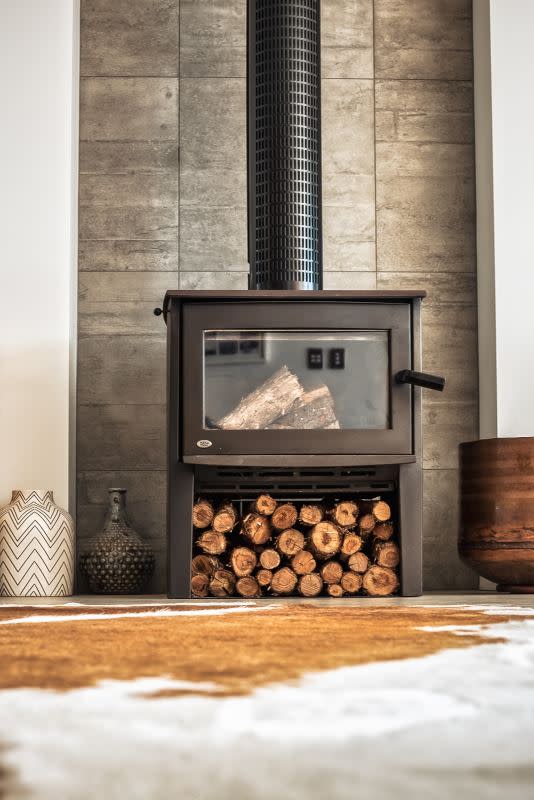How to Prepare Your Fireplace for Winter
Preparing a fireplace for winter weather ensures both safety and efficiency. There's nothing quite like the warmth and ambiance of a fireplace during the winter, but it's important to prioritize its maintenance, keep your home and family safe, and reduce the risk of chimney fires.
While summer is a great time to get your fireplace maintained because trusted companies have more flexibility in their schedule, it's a year-round industry. Local chimney inspectors recognize the importance of fireplace upkeep in the winter season, and are readily available to help you keep your home safe.
The Importance of a Fireplace Inspection and Cleaning
In wood-burning fireplaces, sticky creosote residue begins to line your chimney and fireplace. Over time, creosote can harden and become highly flammable, leading to house fires.
Gas fireplaces also need annual maintenance to test the ignition system, examine the burner and venting, and ensure proper gas pressure and CO levels.
Professional inspections and cleanings help identify and remove creosote deposits, reducing the risk of fire. An inspection ensures the best, safest fireplace performance all season long, not just during the winter months. Don't underestimate the importance of routine maintenance in preserving both the safety and efficiency of your home.
Related: Carbon Monoxide Safety Tips to Keep Your Home Safe

Photo by Krystal Black on Unsplash
What does a chimney inspector do during a routine inspection?
Use a camera to inspect the entire venting system, including the vent and chimney flue, for obstructions, buildup of creosote, nests and other blockages, or signs of damage to the masonry. Proper venting is necessary for the expulsion of combustible material. Many of these steps apply to an electric fireplace, too.
Check the gas valve, pilot light, and ignition system in gas fireplaces. This verifies that the pilot light ignites promptly and stays lit.
Examine the gas fireplace burner for proper ignition, flame characteristics, and an even distribution of heat
Check that the mesh-metal screen of a gas fireplace is intact. The mesh screen is a safety feature.
Perform carbon monoxide (CO) testing for a gas fireplace. A system that doesn't pass puts the user at risk of carbon monoxide poisoning.
Inspect the chimney structure to look for cracks, chimney cap damage, loose bricks, damaged mortar, and signs of water damage. (If there's a structural issue or a need for fireplace mortar repair, they can refer you to an exterior chimney repair specialist.)
Address any safety issues promptly to prevent further damage
What does a professional chimney sweep do?
Cover everything with drop cloths
Use a fireplace shovel and soft cloths to remove soot buildup inside the firebox and around the fireplace mantle and hearth
Clean your fireplace grate
Clean the glass fireplace screen or mesh screen
During the cleaning, just like an inspector, they'll do a visual inspection to check the chimney and flue for damage.
Install a top-sealing damper for better insulation
Open and close the damper to ensure smooth operation
Consider installing a top-sealing damper for better insulation when the fireplace is not in use
Related: How to Remove an Ugly Fireplace Surround
10 Safety Tips You Can Handle Yourself
Inspect the hearth and surroundings. Ensure there is no flammable material near the fireplace, such as curtains or furniture.
Check the batteries in your smoke detector and carbon monoxide alarms
Buy a fire-resistant rug. Place it in front of the fireplace for added safety.
Stock up on well-seasoned firewood, such as oak or maple. It ensures a consistent and efficient burn. You should only burn seasoned wood to reduce creosote buildup.
Store firewood in a dry, covered area to prevent moisture absorption. "Wet logs can cause a fire to burn at a lower temperature, leading to an inefficient heating process," adds Matthew Lake of Guardian Safe and Vault. "To compensate, people might overload the fireplace or stove to generate more heat, which can result in overheating. Overheating of the stove or fireplace itself can create dangerous situations, including the potential for fires to spread beyond the intended confines."
Remove fireplace ashes with a fireplace shovel. A thin layer is okay, but too many ashes can reduce airflow and hinder efficiency. Wear a safety mask while you're cleaning!
Upgrade to glass fireplace doors to improve energy efficiency. Glass doors also prevent drafts when the fireplace is not in use.
Use a fireplace screen to capture hot embers
Keep the doors open while a fire is burning for proper ventilation
Never leave a fire unattended. Extinguish it completely before going to bed or leaving the house.
Related: Are You Prepared for an Early and Severe Winter?
By taking the time to prepare for the active fireplace season, you effectively prioritize safety and efficiency. Regular maintenance, chimney inspections, and safe burning practices will put you at ease during the winter as you relax by the fire. Embrace the season, and enjoy the comfort that a well-prepared fireplace brings to your home.